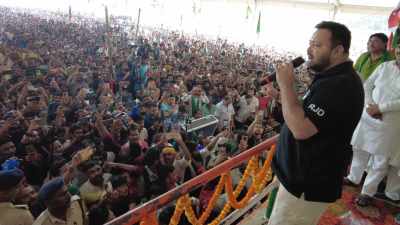Stay updated with the latest - Click here to follow us on Instagram
As usual, rain lays waste to city
While the BMC says it has taken steps for effective garbage collection across the city, the claim rings hollow.
 As the rains throw the city out of gear, so does the Brihanmumbai Municipal Corporation’s elaborate solid waste management unravel.
As the rains throw the city out of gear, so does the Brihanmumbai Municipal Corporation’s elaborate solid waste management unravel.
Every year, as monsoon sets in, Mumbai not only battles perennial problems of waterlogging and potholes, but also the rising stench of uncollected waste. While the BMC says it has taken steps for effective garbage collection across the city, the claim rings hollow. TANUSHREE VENKATRAMAN checks out the ground reality
Overflowing wet garbage bins, uncollected waste from desilted drains and decomposing urban waste by the roadside are common sight during Mumbai’s monsoon season.
More than 14 years after the government laid down specific guidelines for collection, transportation and disposal of garbage in the Municipal Solid Waste (Management and Handling) Rules, 2000, the civic body is yet to successfully establish a system for providing residents with this basic service. As the rains throw the city out of gear, so does the Brihanmumbai Municipal Corporation’s elaborate solid waste management unravel.
“The problem of solid waste management in Mumbai worsens in the monsoons as garbage is usually found lying on the road, and not inside the bins. It starts floating because of water-logging in major spots, causing extremely unhygienic conditions that add to the list of monsoon ailments citizens suffer from. The main problem is that there is no professional touch to the entire process of waste collection,” says Dr Amiya Sahu, founder of National Solid Waste Association of India (NSWAI) who is also a member of the Planning Commission’s task force for Solid Waste Management (SWM) for the country.
Plan-wise, the BMC has an elaborate scheme for managing the 6,500 metric tonnes of waste generated daily by residents of Mumbai, which attempts to closely monitor and manage nine companies appointed for waste collection and transportation. However, the ground reality reveals many loopholes and gaps that require immediate redressal.
JOURNEY OF WASTE
Every housing society appoints its own local garbage collector to carry out door-to-door collection, who then carries over the society’s daily generated waste to the municipal corporation’s fleet of 2,209 garbage collection vehicles. These vehicles work on close to 60 routes in every ward mapped across Mumbai in three shifts through the day – at 7 am, 2 pm and 10 pm.
The civic-appointed collectors report to the Motor Load (ML) chowkies located in every ward, where they begin their journey from. Wards such as G/North (Dadar), K/East (Andheri East), K/West (Andheri West and Oshiwara) and L (Kurla, some parts of Ghatkopar and Vikhroli) may have two MLs owing to their larger areas. At the chowkie, each vehicle’s attendance is recorded and collectors are given tools and equipment for handling garbage collection along with a log sheet of the various collection points to be covered in the day. As per the MSW Rules, 2000, collectors must be equipped with items such as face masks, rubber gloves, reflector jackets and safety shoes. However, collectors are rarely seen using the equipment while handling urban waste.
The rules also state that vehicles used for transportation of waste shall be covered so that waste is not visible to the public or exposed to open environment that could lead to waste being scattered. However, there are regular complaints of compactor vehicles being left open, with waste scattering all over the road. Apart from other large vehicles, the BMC manages 634 large compactors, 456 mini-compactors and 325 small closed vehicles. “All the waste collectors are handed specific routes that they are expected to follow. These were designed in 2005 and revised last year with the expansion of the city. Almost 60 per cent of the garbage collection is completed in the morning shift, followed by 30 per cent in the second shift and 10 per cent in the last shift,” said a senior civic official from the Solid Waste Management (SWM) department of the civic body.
Pointing out gaps in the programme, James John, co-ordinator of citizen group AGNI, says, “There is no back-up system even if one of the vehicles needs repair works. If the workers go on a strike, the city is in complete paralysis because we have no replacement system. Many residents also complain that the garbage collectors do not cover all the societies that they are designated to.”
However, the civic body contends that the perception that waste remains uncollected largely exists due to improper management of municipal waste in areas under the jurisdiction of other state agencies.
SEGREGATION OF GARBAGE
It is another major point of contention between the BMC and residents. Since 2013, the BMC has served about 16.6 lakh notices to housing societies and commercial establishments for failing to comply with waste segregation norms.
“We expect the housing societies to segregate dry from wet waste, which they do not do. We are planning to create more awareness in the city so that people understand the concept of segregating waste and help maintain their own city,” a BMC official said.
However, activists complain such measures are half-hearted if the civic body fails to provide services for collecting segregated waste. “There are many housing societies which segregate the waste beforehand, only to find out it is mixed by the waste collectors. The civic body is quick to prosecute societies but even after segregation, the waste is mixed and dumped into the same collection vehicle,” says citizen activist Nikhil Desai.
In February 2014, the Corporation finalised a Rs 2.2-crore contract for a period of one year for collecting dry waste from across Mumbai. Dry waste segregation centres have been set up in 11 wards, where the job has been assigned to women self-help groups, mainly women rag-pickers who could earn from the recyclable waste they segregate and sell to recycling companies. However, residents complain services remain erratic and in many parts, they are unaware of the new facilities.
From checkposts to dumping grounds
After collecting garbage on the allotted routes, the compactors arrive at the local ward’s checkposts where the attendance at each collection point is marked and the amount of waste of collected is assessed. The vehicles are filled as per their capacity, with smaller compactors carrying 2.5 metric tonnes of waste and larger ones 6 metric tonnes. From here, the larger vehicles are sent to dumping grounds at Deonar and Mulund, while the smaller vehicles are dispatched to the four transfer stations located at Mahalakshmi (with a capacity for transferring 750 metric tonnes of waste), Kurla (700 metric tonnes), Versova (350 metric tonnes) and Gorai (250 metric tonnes). From here, garbage is transferred to bigger vehicles and transported to the dumping grounds.
According to the MSW Rules, 2000, municipal authorities must establish and maintain storage facilities in such a manner that they do not create unhygienic and insanitary conditions around it.
However, the city’s four transfer stations fail in this regard.
Rajkumar Sharma, an activist from Chembur, said, “I have seen transfer stations in different cities within the country where they look like bungalows with a garden. The four transfer stations in Mumbai are the filthiest stations one can ever see. The BMC thinks its work is over after just picking up and dumping the waste.”
On reaching the actual dumping grounds, authorities at the site weigh the vehicles and log in the vehicle’s attendance. The compactors are then let into the grounds in a single file to offload the waste at the designated spot. Of the 6,500 metric tonnes of waste collected daily, Deonar receives about 5,500 metric tonnes while Mulund receives about 500 metric tonnes. These two grounds overreached capacity more than five years ago and have been due for closure ever since. The height of waste tower at Deonar is about 55 metres, much more than the 35 meters as mandated by the Airports Authority of India. Despite a critical need, none of the dumping grounds have a single waste processing unit. The new Kanjurmarg dumping ground is the city’s only landfill which has a facility for scientifically processing municipal waste. However, this too has been stuck in litigation in the Bombay High Court as environmental organisations, including the Maharashtra Coastal Zone Management Authority (MCZMA), have opposed illegal dumping on wetlands and areas under coastal regulatory zone (CRZ) areas that fall within the landfill site’s area of 141 hectares.
Meanwhile, the BMC claims the 2,000-2,500 metric tonnes of construction waste (debris and silt) generated daily is being sent outside the city for dumping. “Though the civic body has started a helpline for collection of debris, there continues to be a blame game between departments for collecting the debris generated from cleaning storm water drains, which lies unattended on roads for days together,” Desai says.
Slum sanitation drive
The Rs 95-crore slum sanitation and solid waste management scheme launched in January 2013 by the BMC aims at house-to-house garbage collection in slum areas, cleaning of internal roads, small drains and public toilets and also increasing public awareness. Through a lottery system, the civic body appointed close to 738 NGOs for the job. “The waste collectors are called ‘swayam sevaks’, who are paid Rs 6,000,” a BMC official said. This scheme has replaced the erstwhile Dattak Vasti Yojana, which too engaged volunteers in managing solid waste generated in slum areas.
Launched by the BMC in 2001, the Dattak Vasti Yojana ran into controversy in 2011 for rampant corruption and that misappropriation of funds.
The funds for implementation of the new scheme will be released after approval from the BMC’s finance department.
“In the name of NGOs, politicians root for their people and earn money out of this scheme. The Dattak Vasti Yojana, which was introduced for regular collection of waste from the slums areas, failed miserably. The new scheme too hardly looks at these problems. Work done by volunteers should be inspected and photographs should be taken at the end of the day to track progress, the BMC does not follow it,” said John.
A senior BMC official said a new monitoring mechanism would be put in place to address the issue soon.
THE WAY FORWARD
“There should be an active approach to identifying and solving the faults that exist in every step of the BMC’s process of solid waste management. The civic body and the politicians together have to ensure that they not only create awareness about segregation of waste and not littering in public but also tell people about the adverse impacts if they do not follow it. The BMC should conduct studies on the amount of waste generated, the strategic location where the bins should be placed, the transportation problems encountered in the system and how the city can benefit financially by following a thorough process,” Dr Amiya Sahu said.
Conceding that there could be gaps in its solid waste management programme, the civic body has brought in a global analytical company to develop a system that will facilitate checks with minimum dependence on manual monitoring through on-site employees. The BMC is keen to incorporate remote real-time monitoring of the system instead as part of its initiatives to comply with the service level benchmarks set up by the Ministry of Urban Development’s (MoUD) for providing quality basic civic services to citizens. Apart from effective garbage collection, the civic body will also have to ensure 80 per cent recovery of collected waste through recycling, 100 per cent scientific disposal of municipal solid waste, 100 per cent extent of cost recovery in SWM services and 90 per cent efficiency in collection of SWM charges.
Through its new project, the BMC hopes to scientifically analyse the current status of its services and create time-bound solutions to plug the gaps and problems here.
“We are working on removing the human element in the monitoring of all services. Instead of assigning officers to inspect the work, it will be monitored from the offices through live feeds. This way, we are not merely saying we following the first SLB is not merely on paper but backed with actual recorded information,” said Deputy Municipal Commissioner (SWM), Prakash Patil.
tanushree.venkatraman@expressindia.com







